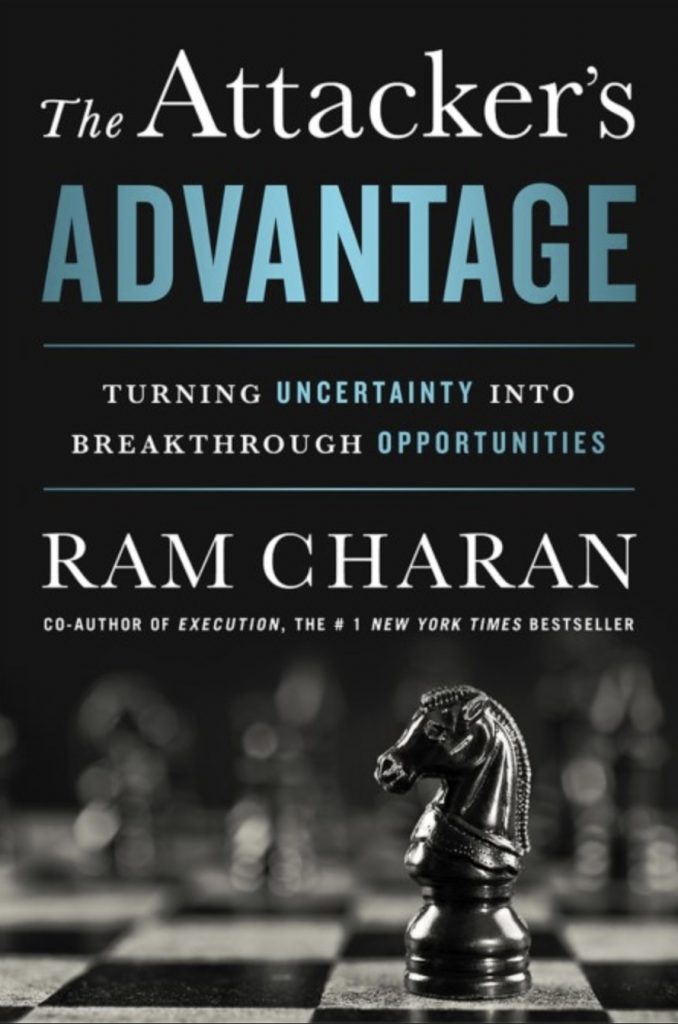Key Quote:
The ‘aha’ moments come from observing both the external environment and the consumer and imagining the ultimate in convenience or cost from the consumers perspective” (p. 81). — Ram Charan
Key Points and Concepts
The Fundamental Leadership Challenge of Our Time
The fundamental leadership challenge of our time is to take control of uncertainty.
Structural uncertainty refers to the probability of the occurrence of an event that would reconfigure an entire market or system.
“You can manage operational uncertainty with existing tools. But a structural uncertainty arises from your outside environment” (p. 20).
Charan identifies three qualities needed to meet the challenges of uncertainty:
• Perceive sources of uncertainty ahead of others.
• Take advantage of uncertainty to go on the offense.
• Steer the organization to adapt in tune with sudden changes in the environment.
This structural uncertainty creates new possibilities and lowers barriers to entry for those who can recognize opportunities and act decisively.
Building Perceptual Acuity
A catalyst is “…a person with exceptional perceptual acuity who seizes upon a force or combination of forces” (p. 37).
Perceptual acuity is the ability to sense upcoming events, trends, or anomalies.
“By identifying a catalyst driving a major shift you can form an idea of how big it might be and its timing” (p. 42).
Watching for accelerating trends, extraordinary events, and potential scalability in, and out of, a given industry can help in preparing to shape future operations.
Expanding a leader’s information network outside of their given industry, country, and comfort zone can allow them to widen their lens and recalibrate their thinking.
Charan recommends taking ten minutes in every staff meeting to discuss anomalies in the external landscape as a way to cultivate external focus and reduce future resistance to change.
Other practices to build perceptual acuity include seeking contrary viewpoints, dissecting past events, diving into sources of risk, building a mental map of changes across industries, considering the use of an invention or patent down the road, watching social trends, and reading voraciously.
Going on the Offense
Defining a path for going on the offensive involves identifying developments that can be used to give consumers a better experience.
This also involves recognizing the short shelf life of the core competencies and competitive advantage of a current business practice or strategy.
A focus on the full consumer experience and an understanding of analytics can be used to help set this path.
“The ‘aha’ moments come from observing both the external environment and the consumer and imagining the ultimate in convenience or cost from the consumers perspective” (p. 81).
Going on the offensive often involves removing or eliminating subconscious restraints. These blockages include attachment to core competencies, inability to build a new core competency, obsolescence of key people, fear, and avoidance of opposition.
“Becoming aware of your psychological blockages and working incessantly to overcome them will free your thinking to conceive a new path, but ultimately, this is a test of your courage.” (p. 98).
Making the Organization Agile
Streamlining an organization’s connection with its external environment will allow for the agility needed to redirect or change the focus of the organization.
Charan recommends using Joint Practice Sessions, or meetings in which transparency is a focus and the group forms a common view of the total picture.
Charan asserts the importance of identifying crucial decision nodes, or the specific points in an organization at which important decisions are made. To effectively understand and use decision nodes it is critical to:
• Identify decision nodes by working backwards from past actions.
• Assign top leaders to critical nodes.
• Pinpoint the right expertise for that area or decision process.
• Monitor how the nodes are working.
The challenge of adjusting organization involves maintaining business and revenue in one area while shifting to new initiatives and priorities.
Charan, Ram. (2015). The Attacker’s Advantage: Turning Uncertainty Into Breakthrough Opportunities. Public Affairs.

“The difference between how people communicate in the internet era boils down to a fundamental question of “You can manage operational uncertainty with existing tools. But a structural uncertainty arises from your outside environment.”
“The ‘aha’ moments come from observing both the external environment and the consumer and imagining the ultimate in convenience or cost from the consumers perspective.”
Other practices to build perceptual acuity include seeking contrary viewpoints, dissecting past events, diving into sources of risk, building a mental map of changes across industries, considering the use of an invention or patent down the road, watching social trends, and reading voraciously.
“Becoming aware of your psychological blockages and working incessantly to overcome them will free your thinking to conceive a new path, but ultimately, this is a test of your courage.”
